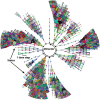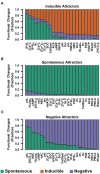Discrete Dynamic Model of the Mammalian Sperm Acrosome Reaction: The Influence of Acrosomal pH and Physiological Heterogeneity
- PMID: 34349664
- PMCID: PMC8328089
- DOI: 10.3389/fphys.2021.682790
Discrete Dynamic Model of the Mammalian Sperm Acrosome Reaction: The Influence of Acrosomal pH and Physiological Heterogeneity
Abstract
The acrosome reaction (AR) is an exocytotic process essential for mammalian fertilization. It involves diverse physiological changes (biochemical, biophysical, and morphological) that culminate in the release of the acrosomal content to the extracellular medium as well as a reorganization of the plasma membrane (PM) that allows sperm to interact and fuse with the egg. In spite of many efforts, there are still important pending questions regarding the molecular mechanism regulating the AR. Particularly, the contribution of acrosomal alkalinization to AR triggering physiological conditions is not well understood. Also, the dependence of the proportion of sperm capable of undergoing AR on the physiological heterogeneity within a sperm population has not been studied. Here, we present a discrete mathematical model for the human sperm AR based on the physiological interactions among some of the main components of this complex exocytotic process. We show that this model can qualitatively reproduce diverse experimental results, and that it can be used to analyze how acrosomal pH (pH a ) and cell heterogeneity regulate AR. Our results confirm that a pH a increase can on its own trigger AR in a subpopulation of sperm, and furthermore, it indicates that this is a necessary step to trigger acrosomal exocytosis through progesterone, a known natural inducer of AR. Most importantly, we show that the proportion of sperm undergoing AR is directly related to the detailed structure of the population physiological heterogeneity.
Keywords: acrosome reaction; discrete dynamics; dynamic model; mammalian fertilization; pH regulation; physiological heterogeneity; regulatory network; sperm signaling pathway.
Copyright © 2021 Aldana, Carneiro, Martínez-Mekler and Darszon.
Conflict of interest statement
The authors declare that the research was conducted in the absence of any commercial or financial relationships that could be construed as a potential conflict of interest.
Figures










Similar articles
-
Two-pore channel 1 and Ca2+ release-activated Ca2+ channels contribute to the acrosomal pH-dependent intracellular Ca2+ increase in mouse sperm.J Physiol. 2023 Jul;601(14):2935-2958. doi: 10.1113/JP284247. Epub 2023 Jun 6. J Physiol. 2023. PMID: 37278367
-
Characterization of a novel role for the dynamin mechanoenzymes in the regulation of human sperm acrosomal exocytosis.Mol Hum Reprod. 2017 Oct 1;23(10):657-673. doi: 10.1093/molehr/gax044. Mol Hum Reprod. 2017. PMID: 29044420
-
Acrosomal alkalinization occurs during human sperm capacitation.Mol Hum Reprod. 2022 Mar 8;28(3):gaac005. doi: 10.1093/molehr/gaac005. Mol Hum Reprod. 2022. PMID: 35201340
-
Role of Ion Channels in the Sperm Acrosome Reaction.Adv Anat Embryol Cell Biol. 2016;220:35-69. doi: 10.1007/978-3-319-30567-7_3. Adv Anat Embryol Cell Biol. 2016. PMID: 27194349 Review.
-
Mammalian sperm interaction with extracellular matrices of the egg.Oxf Rev Reprod Biol. 1989;11:339-88. Oxf Rev Reprod Biol. 1989. PMID: 2697832 Review.
Cited by
-
Oxidative Stress and Acrosomal Status of Human Spermatozoa Subjected to Hydrophobic Carbon Soot Treatments.Nanomaterials (Basel). 2024 Feb 21;14(5):395. doi: 10.3390/nano14050395. Nanomaterials (Basel). 2024. PMID: 38470726 Free PMC article.
-
Techniques to Determine Mammalian Sperm Capacitation.Methods Mol Biol. 2025;2897:463-495. doi: 10.1007/978-1-0716-4406-5_31. Methods Mol Biol. 2025. PMID: 40202654
-
The pair ceramide 1-phosphate/ceramide kinase regulates intracellular calcium and progesterone-induced human sperm acrosomal exocytosis.Front Cell Dev Biol. 2023 Mar 31;11:1148831. doi: 10.3389/fcell.2023.1148831. eCollection 2023. Front Cell Dev Biol. 2023. PMID: 37065849 Free PMC article.
-
Advances in Molecular Biology and Immunology of Spermatozoa and Fertilization in Domestic Animals: Implications for Infertility and Assisted Reproduction.Curr Mol Med. 2025;25(2):167-186. doi: 10.2174/0115665240306965240802075331. Curr Mol Med. 2025. PMID: 39572916 Review.
-
Toll-like Receptor 2 is Involved in Calcium Influx and Acrosome Reaction to Facilitate Sperm Penetration to Oocytes During in vitro Fertilization in Cattle.Front Cell Dev Biol. 2022 Feb 24;10:810961. doi: 10.3389/fcell.2022.810961. eCollection 2022. Front Cell Dev Biol. 2022. PMID: 35281105 Free PMC article.
References
LinkOut - more resources
Full Text Sources
Research Materials

